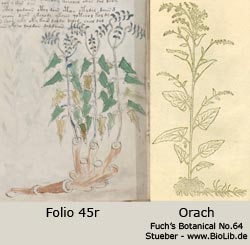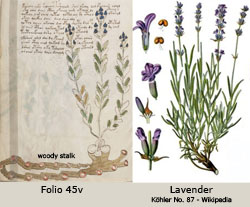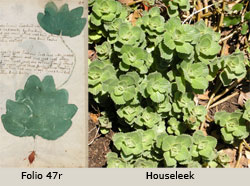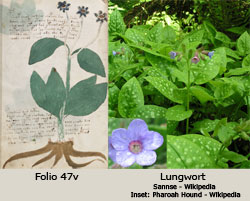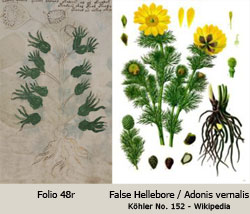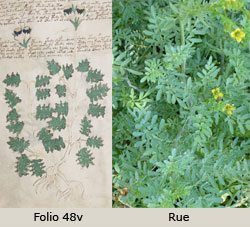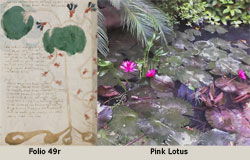The Voynich Botanical Plants
Folio 44v, Celery (Apium graveolens), has been cultivated around the Mediterranean for centuries. It is grown for its crisp stalk, fleshy taproot, and seeds which are used for flavoring. Celery leaves and flowers were part of the garlands found in the tomb of Tutankhamun, a pharaoh of ancient Egypt. The root is an effective diuretic and has been used to treat urinary stones and gravel. The seeds were used by Aulus Cornelius Celsus in around 30 AD to relieve pain. A photograph of a celery flower can be seen at the Weed ID / Management Web site.
Folio 45r, Orach or Saltbush (Atriplex hortensis), grows around Europe and the Mediterranean region and is considered to be one of the oldest cultivated plants. The leaves are arrow shaped; the angular, furrowed stems are 5-6 feet high; and the small green or red flowers occur in profusion at the top of the plant. Orach was mentioned in the book of Job as a food eaten by outcasts from society. It may be eaten as a substitute for spinach.
Folio 45v, Lavender (Lavandula angustifolia), is a low growing shrub, native to the Mediterranean and North African Countries. Opposite, linear leaves grow along its many-branched, woody stems. Young shoots from these stems end in blunt spikes of lavender blue flowers. Romans used the flowers as a perfume for their baths. During the Middle Ages gloves were impregnated with lavender to ward off the plague. Fleas, carriers of the plague, dislike the odor.
Folio 46r, The Oxeye Daisy (Leucanthemum vulgare), is found all over Europe. It is also known as the Lawn or English Daisy. This herbaceous plant produces additional plants from short creeping rhizomes. The small, rounded or spoon-shaped leaves grow close to ground. The flowers, at the end of a leafless stalk, consist of white ray florets surrounding a yellow disc. The daisy was an ingredient of an ointment used in the fourteenth century to treat wounds and gout. The leaves may be eaten raw in a salad.
Folio 46v, Ploughman’s Spikenard or Great Fleabane (Inula conyza), is native to Europe, Asia, and Africa. The name Inula dates back to the Romans. This is a tall, rather plain plant, with a biennial root, oval leaves resembling those of a foxglove, and clusters of ray-less, dull, yellow flowers. A decoction of Ploughman’s Spikenard was frequently used for bruises, ruptures, and internal wounds; the juice from the plant was used to soothe itchy skin. The leaves were burnt as an insecticide to destroy fleas.
Folio 47r, Houseleek (Sempervivum tectorum), is a small, succulent plant native to Europe and Northern Africa. It has rosettes of leaves which grow close to the ground. Houseleek propagates by seed and also by splitting off lateral rosettes, called "hen and chicks." Each plant grows for several years before flowering after which it dies. It is a very old medicinal and witch-plant. The Romans grew it in vases in front of their houses and Charlemagne ordered it to be planted upon the roof of every house to protect the home from fire and lightening.
Folio 47v, Lungwort (Pulmonaria officinalis), a member of the borage family is native to Europe and Western Asia. The scientific name Pulmonaria is derived from Latin “pulmo” for lung. The speckeled, alternate, oval leaves resemble a diseased or ulcerated lung, and this plant was therefore used to treat pulmonary infections. Lungworts are perennial herbs that form clumps as a result of their slowly creeping rhizomes. The blue, funnel-shaped flowers have five (rarely more) shallow lobes.
Folio 48r, False Hellebore or Sweet Vernal (Adonis Vernalis), is found in the drier regions of Southern Europe. The flowers of this plant are yellow. The author of the VM appears at times to be limited or without different colored paints; this may be one example. False Hellebore has properties similar to digitalis for stimulating the heart, but its action is stronger and is said not to be cumulative.
Folio 48v, Rue or Herb of Grace (Ruta graveolens), is a hardy evergreen shrub, native to southern Europe, with a reputation as a medicinal herbal and for protection against plagues, pestilence and witchcraft. The woody stem has alternate, bluish-green pinnate leaves and terminates with bunches of small, greenish-yellow flowers. Apart from being the herb for remembrance, rue has been used to treat stomach, intestinal and menstral cramps and to induce abortions. Michelangelo and Leonardo Da Vinci ate the leaves of this plant to improve their eyesight and creativity.
Folio 49r, Blue Nile Lotus (Nymphaea caerulea), the sacred narcotic flower of ancient Egypt, is actually a water lily. The plant's tuberous roots embed in mud at the bottom of ponds, the leaves float on the surface of the water, and the blue flowers rise above the water. The flower rises above the surface of the water in the morning, opens and closes, and then sinks again in the evenings. The ancient Egyptians equated the behaviour of this plant, with their sun god, Isis. According to the Odyssey, the Lotus Eaters were a happy, indolent people as a result of eating the lotus for its soporific and psychedelic effects. When Odysseus landed among them, some of his men ate their food. They forgot their friends and home and had to be dragged back to the ships. (The Lotus Shop)

